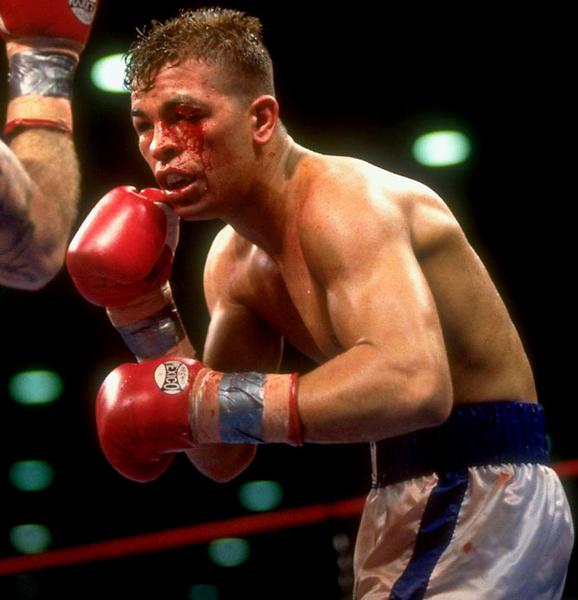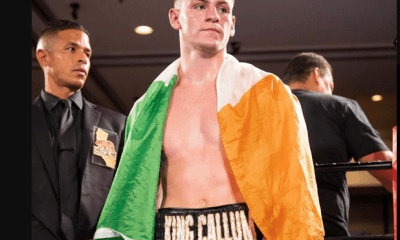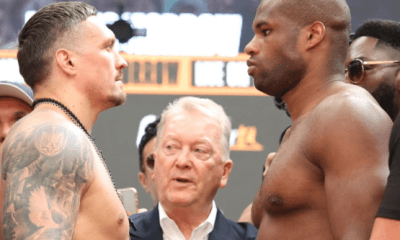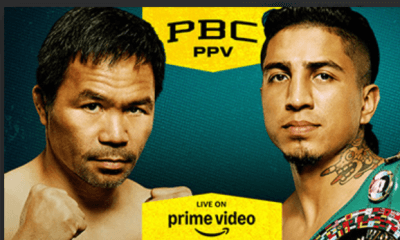Featured Articles
When Life Imitated Art: The Birth of the Legend of Arturo Gatti

In retrospect, the timing was eerily appropriate. Less than 24 hours after Arturo “Thunder” Gatti announced himself as his generation’s most compelling action fighter, Braveheart, a film about William Wallace, the legendary, late 13th century Scottish warrior, took the Best Picture Oscar at the 68th annual Academy Awards.
Nor was that the only applicable movie analogy after the nearly blinded Gatti’s epic sixth-round knockout of Wilson Rodriguez on March 23, 1996 – to be technically accurate, very early on March 24, considering that the fight, the second installment of HBO’s recently launched Boxing After Dark series, ended at 12:40 a.m. in the Eastern time zone. Upon entering his dressing room at Madison Square Garden, Gatti, his face a lumpy mess, turned around and shouted, to no one in particular, a familiar catch-phrase from Rocky, the fictional tale of a never-say-die boxer which was named Best Picture of 1977.
“Yo, Adrian, I did it!” screamed an exuberant Gatti, just 22 days shy of his 24th birthday and possibly unaware that his promising ring career had just crossed over into a different dimension.
“That was the transitional fight that took Gatti from being a budding attraction and a champion (the back-from-the-brink conquest of Rodriguez was his first defense of his IBF junior lightweight title) to being a cult figure,” Lou DiBella, now a promoter but then the senior vice president of HBO Sports, said when contacted for his thoughts on a slugfest that became an instant classic, one of many authored by a fighter who demonstrated time and again he was always ready, even eager, to go down into the trenches.
“There’s no question that fight changed everything. It was a Rocky movie, the most dramatic fight I’ve ever seen to this day. I’m not going to say it’s the best fight I’ve ever seen, but it certainly was the most dramatic. The myth and legend of Arturo Gatti was born that night.”
Pat Lynch, Gatti’s manager, agrees with DiBella that the Rodriguez bout represented a sea change for his Italian-born, Montreal-reared, Jersey City-based fighter.
“There were a few people who knew how entertaining and exciting Arturo could be, but that’s the one that really put him on the map because it was televised by HBO and a lot of people got to see it,” Lynch recalled. “He had shown signs of being that guy early on, in a fight against Leon Bostic (winning an eight-round majority decision on Jan. 8, 1994, in Catskill, N.Y.). I remember that fight vividly. I was walking back to the dressing room when Al Gavin (a veteran cutman) made a sign with his hands as if to say, ‘That kid’s got ‘em (cojones) this big.’ That was the kind of throw-down war that Arturo came to be known for, but his coming-out party was definitely the Wilson Rodriguez fight.”
It is curious then that Gatti-Rodriguez has become, if not exactly forgotten, a somewhat lesser entry in Gatti’s thick file of unforgettable trials by combat. Ask fight fans what they most remember about Gatti – who was just 37 when he died under mysterious circumstances in Brazil on July 11, 2009 — and they’re apt to cite his three bouts with Micky Ward, two of which were won by Gatti. Although Gatti was a participant in three Fights of the Year as selected by The Ring magazine (1997, KO5 of Gabriel Ruelas; 1998, L, SD10 to Ivan Robinson and 2002, L, MD10 to Micky Ward), his demolition derby with Rodriguez was aced out for 1996 Fight of the Year, understandably given its more consequential nature, by Evander Holyfield’s 11th round stoppage of Mike Tyson.
“I think it’s fair to say the trilogy with Micky Ward is the defining memory of Gatti in the ring,” said Larry Merchant, the longtime color commentator for HBO boxing telecasts who was at ringside for Gatti-Rodriguez. “At the time Gatti fought Rodriguez we knew he was an exciting brawler, but given the circumstances – it was just the second Boxing After Dark show – and the theatrical drama of that fight, it’s a part of his legacy, although maybe not as much as his fights with Ward.”
It’s also fair to say that Gatti was not exactly an unknown commodity when he squared off against Rodriguez. Even before he wrested the IBF 130-pound title from Tracy Harris Patterson on a 12-round unanimous decision on Dec. 15, 1995, the ruggedly handsome, tri-lingual Gatti had been identified as a potential superstar with the kind of crossover appeal that would find favor with fringe and even non-boxing fans. Integrated Sports International, a sports management company that represented, among others, Oscar De La Hoya, the NBA’s Hakeem Olajuwon and NFL’s Steve Young and Drew Bledsoe, envisioned Gatti as a key addition to its lineup of athletes who could also serve as commercial spokesmen.
DiBella’s first Boxing After Dark telecast, the main event of which had been WBO super bantamweight champion Marco Antonio Barrera’s 12th-round stoppage of Kennedy McKinney, had been an aesthetic and ratings smash, with Barrera going down once and McKinney four times. Hoping to build on that momentum, DiBella wanted to pair Gatti with Wilfredo Vazquez, a former WBA super bantamweight and featherweight champion who had more name recognition than Rodriguez, a 30-year-old native of the Dominican Republic based in Spain who was the IBF’s No. 2-ranked junior lightweight but had never fought in the United States. Lynch lobbied for Rodriguez, whom he incorrectly believed would pose a somewhat easier test for Gatti after he had gone 12 grueling rounds with Patterson only three months earlier.
“I wanted Vazquez because he was the bigger name,” DiBella reasoned. “I had no problem with Rodriguez. I thought it was a good fight. But I was trying to build a series. We did incredibly well with the ratings for Barrera-McKinney and I wanted to make sure we had a follow-up show that was attractive, so we doubled down with Junior Jones-Orlando Canizales as the lead-in. We had three of the best lower weight-class fighters in the world, and two of them were fighting each other.”
Jones and Canizales held up their end with Jones, a Brooklyn native, winning a minor super bantamweight title on a unanimous, 12-round decision to the delight of the announced attendance of 3,698 (about 800 below capacity) in the Theater at Madison Square Garden. It might have been a tough act to follow, considering that one well-regarded boxing writer had labeled Gatti-Rodriguez as a “gimme” for Gatti, who went in with a 24-1 record and 20 KOs, including 14 in the first round.
Some gimme. Tagged with laser-like accuracy by Rodriguez’s stiff jabs and overhand rights, Gatti returned to his corner after the first round with a puffy left eye and a mouse beginning to form under his right. It got worse for him in the second round, when he was floored with a three-punch combination. He was up at the count of three and, as was his custom, fought back gamely, refusing to clinch, but the condition of both of his eyes was rapidly deteriorating.
Fortunately for Gatti, one of the best cutmen in the business, Joe Souza, had just joined his support crew and was proving to be a valuable addition as he feverishly worked his magic. Souza’s handiwork was evident when the ring physician examined Gatti after both the third and fourth rounds, with Gatti five times correctly answering how many fingers the doctor was holding up. But Gatti knew, as did trainer Hector Roca, that his field of vision would soon be too impaired for him to be allowed to fight on.
In typical Gatti fashion, each time he appeared to inch close to a loss by stoppage, he would launch a counterattack that bought him precious seconds. Despite being docked a penalty point by referee Wayne Kelly in the fifth round for repeated low blows, Gatti ripped a left hook to the liver that put Rodriguez down for a six count in the fifth round. It was a harbinger of what was to follow in the sixth, when, with Rodriguez’s right hand held low to protect his injured side, Gatti went upstairs with another hook that landed flush on the jaw, the challenger collapsing onto his back where he was counted out at the 2:16 mark. He would remain prone, unable to rise, for over a minute.
“We’ve been billing Arturo Gatti as one of the most exciting fighters in the world,” said his promoter, Dino Duva. “I just wish he wouldn’t make it this exciting.”
Kelly was asked how close he had come to awarding a TKO victory to Rodriguez, who was ahead by three points on two of the official scorecards and was behind by one point on the other. “I was close to stopping it in the third,” he said. “But I’ve worked with Gatti before and know he’s very resilient.”
Gatti, of course, went on to become the franchise fighter in Atlantic City, so much so that Lynch observed that “People planned their vacations around going there for the full weekend when Arturo fought there. His fights were that kind of must-see event.
“I pulled up to Bally’s one time and the bell kid came out to get all our stuff. He saw the corner jackets and the robe that were in my car and he asked, `You’re with Team Gatti?’ I said yeah. He goes, `We love it when Gatti comes to town. Everybody makes money.’ And it was true. The taxi drivers made money, there were more restaurant reservations made. His following in Atlantic City just grew and grew. He had a cult following like you’d see anywhere the Grateful Dead played.”
Rodriguez wasn’t so fortunate. He did not get a rematch with Gatti and had only one more meaningful fight, a unanimous decision loss to Angel Manfredy, before retiring in 1999 with a 48-11-3 record and 37 KOs. Perhaps Gatti-Rodriguez has lost some of its original luster because Rodriguez did not rise in prominence as did Ward, whose three-bout passion play with Gatti has made him a more or less equal partner for posterity’s sake.
Gatti was posthumously inducted into the International Boxing Hall of Fame in 2013, an honor more than a few pundits believe is undeserved because he never quite made it to the top tier of superstardom that owes in equal parts to popularity and success inside the ropes. DiBella would argue that Gatti did deserve enshrinement for the excitement he so frequently generated, even if his skills never approached those of De La Hoya and Floyd Mayweather Jr., both of whom defeated him with relative ease.
“Gatti was never a pound-for-pound guy,” DiBella acknowledged. “If you were a warrior and had a good night, you could rumble with Gatti. But he was an incredible fighter, and you can’t rewrite him into Floyd Mayweather. He was just a blood-and-guts warrior. Gatti wasn’t really happy if he didn’t get into a war.”
Bernard Fernandez is the retired boxing writer for the Philadelphia Daily News. He is a five-term former president of the Boxing Writers Association of America, an inductee into the Pennsylvania, New Jersey and Atlantic City Boxing Halls of Fame and the recipient of the Nat Fleischer Award for Excellence in Boxing Journalism and the Barney Nagler Award for Long and Meritorious Service to Boxing.
Check out more boxing news on video at The Boxing Channel
To comment on this story in The Fight Forum CLICK HERE
-

 Featured Articles4 weeks ago
Featured Articles4 weeks agoVito Mielnicki Jr Whitewashes Kamil Gardzielik Before the Home Folks in Newark
-

 Featured Articles7 days ago
Featured Articles7 days agoResults and Recaps from New York Where Taylor Edged Serrano Once Again
-

 Featured Articles6 days ago
Featured Articles6 days agoResults and Recaps from NYC where Hamzah Sheeraz was Spectacular
-

 Featured Articles2 weeks ago
Featured Articles2 weeks agoFrom a Sympathetic Figure to a Pariah: The Travails of Julio Cesar Chavez Jr
-

 Featured Articles2 weeks ago
Featured Articles2 weeks agoCatterall vs Eubank Ends Prematurely; Catterall Wins a Technical Decision
-

 Featured Articles1 week ago
Featured Articles1 week agoPhiladelphia Welterweight Gil Turner, a Phenom, Now Rests in an Unmarked Grave
-

 Featured Articles4 weeks ago
Featured Articles4 weeks agoMore Medals for Hawaii’s Patricio Family at the USA Boxing Summer Festival
-

 Featured Articles4 weeks ago
Featured Articles4 weeks agoCallum Walsh, Umar Dzambekov and Cain Sandoval Remain Unbeaten at Santa Ynez
















